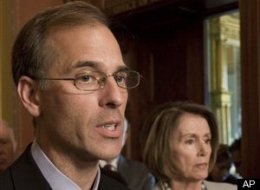By Brigid O’Farrell
Tomorrow, the House Education and Labor Committee will hold hearings in Beckley, W.Va., with the families of the 29 miners who died six weeks ago in an explosion at Massey Energy Co.’s Upper Big Branch mine. The mine had no union and more than a thousand unresolved safety violations on record. President Barack Obama traveled to Beckley last month to lead the nation in mourning.
Seventy-five years ago, on May 21, 1935, First Lady Eleanor Roosevelt defied the superstitions of the era and entered Hanna Co.’s Willow Grove coal mine in Neffs, Ohio, just across the Ohio River from Wheeling, W.Va. Miles beneath the mountain, reported the United Mine Workers Journal, she discussed “wages and working conditions, safety precautions and mining methods, with miners black with coal dust.”
The Willow Grove mine, having been recently updated with new machinery, was thought to be one of the safest in the nation. Five years later, an explosion there killed 73 miners. The First Lady sent her deepest sympathies.
After her first visit to a mining community, in Scott’s Run, W.Va., in 1933, Mrs. Roosevelt regularly denounced dangerous working conditions and opposed feudal company policies that drove miners into debt and forced them to patronize company stores.
A writer and member of the Newspaper Guild, AFL-CIO, for more than 25 years, Mrs. Roosevelt believed there were “only two ways to bring about protection for workers … legislation and unionization.” Legislation set safety standards and exacted penalties for violators while unions gave democratic voice to people in mines, factories and offices, allowing them to negotiate safe working conditions.
Mrs. Roosevelt believed that everyone deserved the right to a decent job, a living wage, safe working conditions and a voice at work. She took this belief to the United Nations and under her guidance workplace rights became part of the Universal Declaration of Human Rights.
Over the years Mrs. Roosevelt had her disagreements with John L. Lewis, the legendary president of the United Mine Workers of America, but she never lost sight of the miners. When Lewis retired in 1959, she paid tribute to his singular contributions in her My Day syndicated newspaper column:
“When Mr. Lewis started out, no one knew what conditions were for mine workers, protective legislation was rare in many states and it was not till he really began functioning that the situation for miners began to improve. … We must be grateful for his accomplishments.”
Union membership grew under New Deal labor policies, reaching 35 percent of the overall workforce and 90 percent of miners in the 1950s. Eventually, mine-safety legislation became law and the Department of Labor began inspecting mines and fining violators. The numbers of fatalities and injuries declined.
Data collected by the United Mine Workers of America today finds union mines safer than non-union mines, and David Moberg of In These Times found that between 2006 and 2009, “unionized miners appear to have been one-fourth to one-half as likely to be killed in mine incidents as their non-union peers.” Industry groups and some regulators dispute union safety claims and some independent researchers have found no correlation between safety and unionization. Unfortunately, the federal Mine Safety and Health Administration doesn’t report safety statistics by union status.
Over the past decade or more, worker-protection enforcement agencies have been severely weakened by policy changes and budget cuts — despite some stiffening of mine regulations after the Sago mine disaster in 2006 — while employer resistance to regulation and unions has increased. Union membership among all private-sector workers has declined to just over 7 percent, and only one-third of coal miners now belong to unions.
Writer Art Levine at Truthout has reported that nearly 70 percent of Upper Big Branch miners had signed cards saying they wanted a union but that three organizing attempts were defeated. Massey CEO Don Blankenship personally met with workers and threatened to close the mine if they voted for a union. Labor expert Kate Bronfenbrener has found that employers threaten to close plants in 57 percent of union representation elections and actually fire workers in one-third of union campaigns.
“If everybody had the right to collective bargaining, all work sites would be a lot safer and a lot healthier for our workers,” believes AFL-CIO President Richard Trumka, an attorney who used to be a miner and president of the UMWA.
Decades earlier, Eleanor Roosevelt argued in her newspaper column that “the right to explain the principles lying back of labor unions should be safeguarded, that every workman should be free to listen to the pleas of organization without fear of hindrance or evil circumstances, and that he should have the right to join with his fellows in a union.” She saw collective bargaining as a way to resolve disputes and she encouraged mediation as an alternative to strikes.
These are the goals of the Employee Free Choice Act, which is languishing in Congress. Under EFCA, if most employees sign valid union “authorization cards,” a company must recognize the union and negotiate a contract or submit to mediation. No longer would elections be required — elections that companies often derail by intimidating workers.
The Upper Big Branch tragedy calls out not only for better and more strongly enforced mine-safety laws, but also for restoring basic human rights to all those who work for a living. Passage of the Employee Free Choice Act would take us one step closer toward Eleanor Roosevelt’s far-reaching vision of workplace democracy.
Brigid O’Farrell is an independent scholar whose book, “She Was One of Us: Eleanor Roosevelt and the American Worker,” will be published in the fall by ILR Press/Cornell University Press. She is affiliated with the Eleanor Roosevelt Papers Project at George Washington University and a member of UAW Local 1981 in the San Francisco Bay area.



